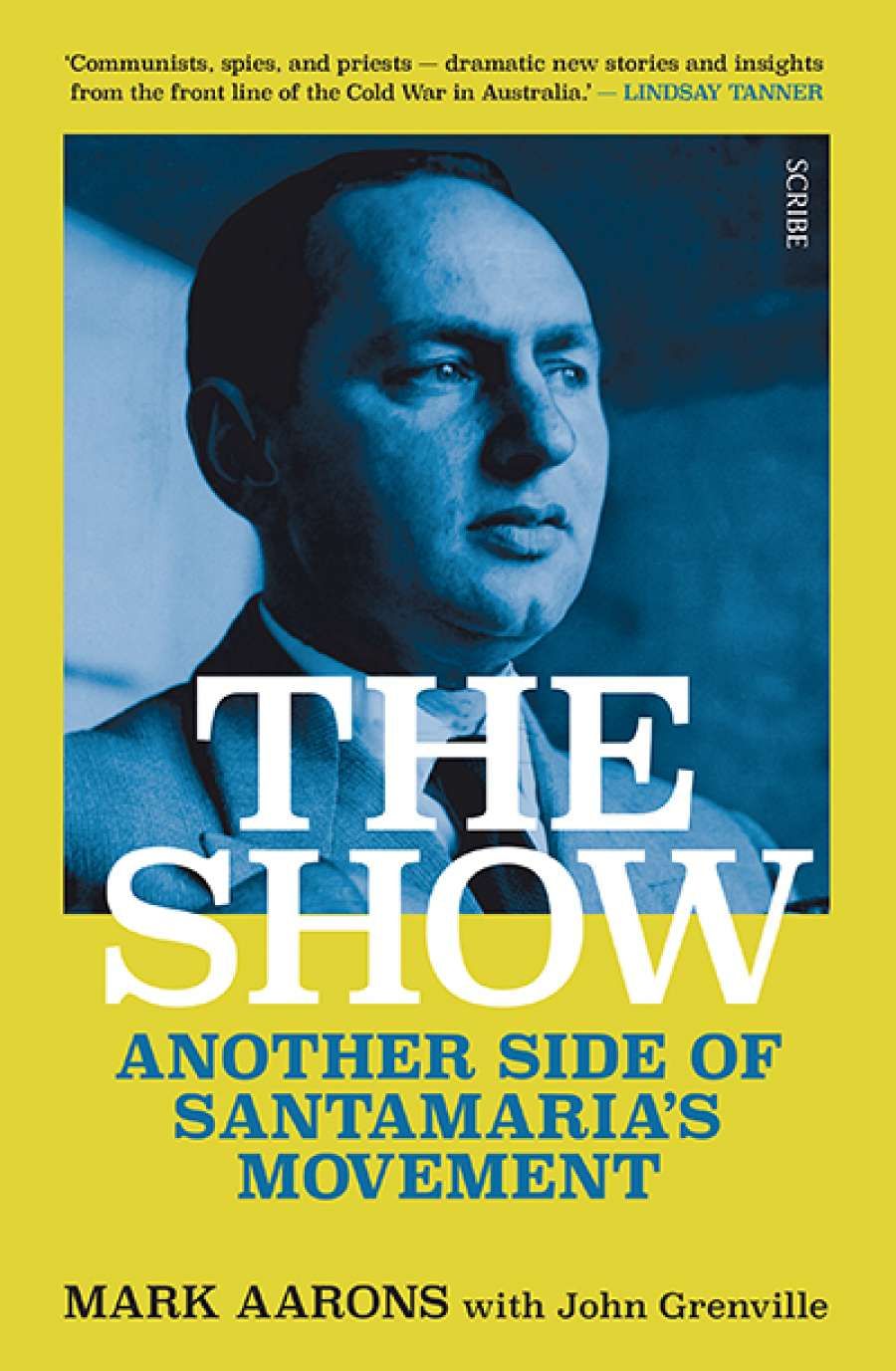
- Free Article: No
- Contents Category: Politics
- Custom Article Title: Lyndon Megarrity reviews 'The Show: Another side of Santamaria’s movement' by Mark Aarons and John Grenville
- Book 1 Title: The Show
- Book 1 Subtitle: Another side of Santamaria’s movement
- Book 1 Biblio: Scribe, $32.99 pb, 282 pp, 9781925322316
A major theme of the book is the extent to which the Movement’s work as a communist fighting machine mimicked the organisation and tactics of the CPA in order to wield influence over the labour movement. Like the CPA, the Movement was not above using propaganda and other underhand methods in order to increase support for its cause. The similarities did not end there. The organisational work of both the CPA and the Movement was based on tight discipline and top down hierarchical control. Activities and policies were driven from central headquarters, and little dissent was permitted.
The authors imply that the Movement’s emphasis on Santamaria’s role as leader was a form of Stalinism. Indeed, Santamaria did largely run ‘The Show’ in a centralised fashion and treated it as his personal fiefdom, but it is probably a stretch to describe Santamaria himself as a ‘Stalinist’ leader. Unlike Stalin, Santamaria did not control the State or its military, and any purges within the Movement did not possess the stark brutality of those in the USSR. True, Aarons and Grenville provide much evidence which suggests that Santamaria, like Stalin, was economical with the truth when it suited his tactical purposes. But ultimately, the Stalinist metaphor outstays its welcome. The authors even see Stalin-like revisionism at work in Santamaria’s recollection that a sensitive Movement document found its way into communist hands when Brisbane Archbishop James Duhig left it in a train under a pillow. This anecdote seems too good to be true, but in his old age Santamaria may simply have preferred to believe it because it was a better story than the more prosaic explanations offered by the authors’ sources.
For all the emphasis on Santamaria, he is a shadowy presence in the book. The concentration on industrial battles and internal Movement disputes leaves little time for understanding the Santamaria phenomenon that made it all possible. A little more historical context on the nature of sectarianism in the postwar years and more information on Santamaria’s agrarian policies would have helped the reader more fully to understand the stakes involved.
 B. A. Santamaria and Catholic Archbishop of Adelaide Matthew Beovich at the first Catholic Action Youth rally in 1943 (Wikimedia Commons)On the other hand, the authors convincingly portray Santamaria as fostering a ‘cult of personality’: he certainly appears to have been less than open towards competing intellectual views within his own organisation. From surviving clips of his long running Point of View television commentary series, it can be clearly seen that Santamaria had an intense and quietly forceful manner, but it is hard to imagine this prim, judgemental figure as a charismatic leader of men. It may be that despite being a layman, he was seemingly cloaked with church authority, as for many years he had powerful supporters within the Catholic hierarchy. The unquestioning authority given to Catholic bishops by the laity in the mid-twentieth century may have been all too easily transferred to Santamaria and his Movement.
B. A. Santamaria and Catholic Archbishop of Adelaide Matthew Beovich at the first Catholic Action Youth rally in 1943 (Wikimedia Commons)On the other hand, the authors convincingly portray Santamaria as fostering a ‘cult of personality’: he certainly appears to have been less than open towards competing intellectual views within his own organisation. From surviving clips of his long running Point of View television commentary series, it can be clearly seen that Santamaria had an intense and quietly forceful manner, but it is hard to imagine this prim, judgemental figure as a charismatic leader of men. It may be that despite being a layman, he was seemingly cloaked with church authority, as for many years he had powerful supporters within the Catholic hierarchy. The unquestioning authority given to Catholic bishops by the laity in the mid-twentieth century may have been all too easily transferred to Santamaria and his Movement.
The Show, meticulous in its referencing, is well-written and presented. However, the decision to provide modern estimates of monetary values along with the old (e.g. ‘£3000 [$203,000]’) is not very useful to the reader, as money notoriously changes its value over time. References to average wages and costs of specific eras would have better assisted the reader trying to comprehend the historical value of pounds, shillings, and pence at a certain time in history.
The authors are to be congratulated on bringing the stories of the Movement to life. In doing so, they have highlighted the human cost of adherence to a secretive and undemocratic organisation that ultimately outlived its purpose. The Show is a poignant reminder of how Australian politics and social life have changed radically since the 1960s. As Aaron and Grenville’s book demonstrates, the Movement depended on the CPA for its mission and vitality. They declined in tandem.


Comments powered by CComment